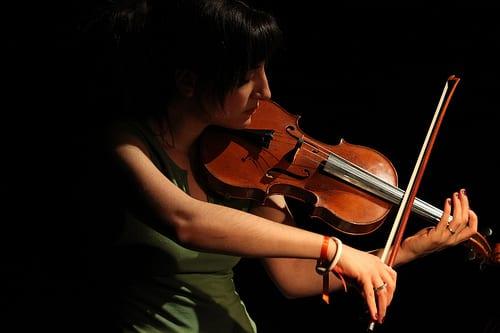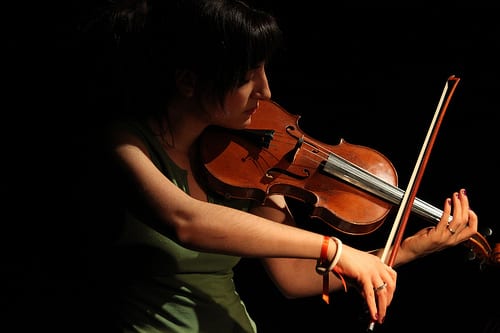Are you a violin player who has difficulty with your fourth finger? If so, you’re not alone. Many people struggle with the challenge of mastering this particular finger. Luckily, there are some effective tips and techniques that can help.
Read on to learn how to tackle the violin fourth finger challenge!
How Can I Improve My Fourth Finger Vibrato Violin?
If you’re looking to improve your fourth finger vibrato violin technique, there are a few things you can do:
- First, make sure you’re using the correct finger. The fourth finger is the one closest to your pinky, so if you’re using any other finger, you won’t be able to produce the desired effect.
- Second, use a light touch when applying pressure to the string. Too much pressure will make it difficult to produce a smooth vibrato.
- Finally, make sure you’re using a consistent motion. Vibrato should be produced by moving the finger back and forth, not by twisting or jerking it.
By following these tips, you should be able to produce a beautiful fourth finger vibrato violin sound.
Still stuck? Consider signing up for violin lessons to learn more fourth finger violin tips and fourth finger violin exercises that can help you out. In addition, you’ll learn helpful violin skills like what you see below:
https://www.youtube.com/watch?v=ev_MLvWnJJc
Why is the 4th Finger Weak?
One of the first things you learn when playing the violin is that the fourth finger is the weakest. This can be frustrating, especially when you see other people playing with all fingers equally strong.
So why is the fourth finger weaker? There are a few theories. One theory is that the fourth finger has a shorter muscle than the other fingers, making it less able to generate the same amount of force.
Another theory is that the fourth finger is used less often than the other fingers, causing it to atrophy.
Whatever the reason, there are ways to overcome this weakness. For example, you can use a heavier bow when practicing or working on strengthening exercises for your fourth finger. With time and practice, you can develop a stronger and more dexterous fourth finger.
How Do You Do the 4th Finger on a Violin?
First, make sure that you’re holding the bow correctly.
The grip should be firm but not too tight, and your thumb and first two fingers should be positioned near the top of the bow. Then, position your fourth finger behind the bow on the string.
Be sure to not place your finger too close to the bridge, as this will produce a sour sound. To produce a note, simply pluck the string with your finger and then draw the bow across it. Doing this correctly will produce a clear, distinct note.
When to Use Fourth Finger Violin
The fourth finger (or pinky) is often seen as less important than its three counterparts when it comes to playing the violin. This isn’t necessarily true, though! In fact, mastering how to use this finger properly can open up a world of possibilities, giving you more control over your sound and making it much easier for you to hit notes accurately. So when should you use your fourth finger?
One of the best times to use your fourth finger on the violin is when you need extra reach for higher notes. If you find yourself having difficulty reaching high notes with just three fingers, try using your fourth finger as well! This will help give you that extra bit of leverage needed to hit those higher notes without straining or forcing your arm into uncomfortable positions. It’s also useful for transitioning between different octaves quickly and easily.
Another great time for utilizing the fourth finger is when performing scales or complex fingering patterns that require multiple shifts in position. Using all four fingers in these instances makes navigating these complex passages simpler and cleaner-sounding; plus, it can help prevent mistakes due to incorrect fingering or poor posture while playing. Having that extra bit of support from another finger can make all the difference in executing difficult passages correctly!
Tips for Mastering the Fourth Finger Vibrato Violin
Mastering finger coordination when you’re first learning how to play the violin can be tricky – but it’s not impossible! Even when it should be simple, however, sometimes keeping that pesky fourth (pinky) finger in line can be a chore. Here are a couple of helpful exercises to take control and gain strength…
Finger Raises
Perfecting your violin technique can be a life-long process. Leopold Auer, author of the book Violin Playing as I Teach It, explains that it can take years for you to overcome “certain muscular weaknesses” in your fingers. Auer recommends independent finger raises to strength your fourth finger and help develop proper technique for trills.
Place your violin in playing position. Raise your left hand up and place your fingers in first position on the “D” string. Raise your fourth finger off the string and drop it back down into position. Listen for the ping of the string to be assured that you are coming down with enough force. Practice on the D and G strings before moving onto the A and E strings. Each string requires a different wrist and elbow angle, and practicing finger raises on each string reinforces the strength and independence of your fourth finger.
Pizzicato Exercises
Pizzicato is usually done by plucking the violin strings with your right hand index finger. Carl Flesch, author of the classic violin book The Art of Violin Playing, states that when playing the violin, you need adequate finger strength to finish lengthy pieces. Left-handed pizzicato exercises will strengthen your fourth finger. Hold your violin in playing position and anchor your first finger on the A or D string. Curve your fourth finger around the string and pluck the string. Keep your hand still and move the fourth finger independently. Do not strike or touch the other strings. Listen for a clear, ringing sound. Pluck loudly and softly to vary the resistance from the string to the finger. Repeat on other strings, and in third, fourth and fifth positions.
You can read the full article here.
How Can I Strengthen My 4th Finger? Lots of Practice!
The old adage “practice makes perfect” is especially true when it comes to playing an instrument like the violin. To really get comfortable using your fourth finger, you need to practice regularly and consistently until you feel confident in your skills.
Try setting aside 10-15 minutes every day dedicated specifically to working on your fourth finger technique—this will help make sure that valuable practice time is actually going towards improving this area in particular instead of being split between several topics at once.
Additionally, try setting mini goals for yourself each week—for instance, work towards playing a certain piece or scale without mistakes by the end of the week. These small achievements will be great motivation as you continue practicing!
Learning how to use your fourth violin finger effectively can be a challenge but also incredibly rewarding when done right! Breaking down each step into manageable chunks and dedicating regular practice time can make all the difference in helping you master this tricky skill.
With patience and dedication, you’ll be playing those pesky fourth notes like a pro in no time! Good luck!
Readers, what other exercises do you work on to strengthen your fourth finger? Leave a comment below, and don’t forget to Like us on Facebook!
You might also like…
– Perfecting Violin Vibrato: 5 Common Mistakes
– Violin Tips: Avoiding the Bouncing Bow
– The Science Behind the Strings
Photo by claire.shovelton.
Suzy S.


